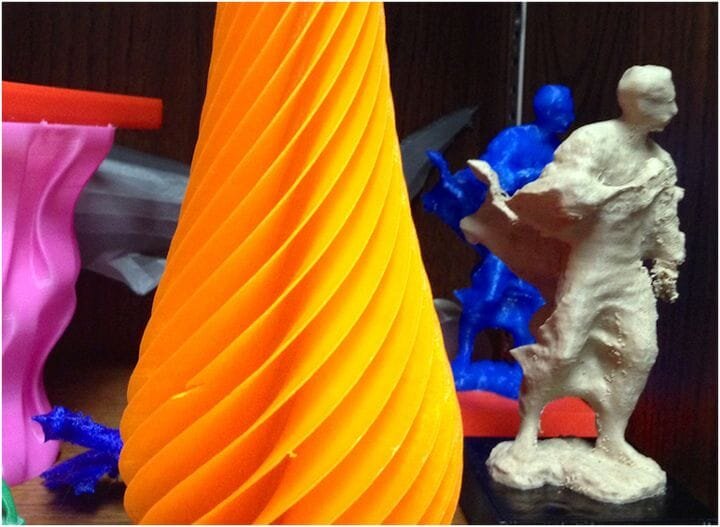![3D printed vase and sculpture [Source: Flickr]](https://fabbaloo.com/wp-content/uploads/2020/05/Sculpture-and-vase_img_5eb08d448e967.jpg)
Charles Goulding and Greer Veon of R&D Tax Savers look at how artists have been remaking the world’s sculptures.
3D printing enables artists to access endless possibilities for sculpting new original works.
However, museums and artists alike find sculptures from the past can also highly benefit from this modern technology. Historians and artists looking to restore ancient sculptures create many opportunities for 3D printing. Companies and designers creating sculptures for profit can obtain R&D tax credits.
Museum Restoration 3D Printing Strategy
One archeologist sees 3D printers and printing technology as a way to merge technology with ancient history. Nestor Marques, an archeologist specialized in the Roman world, travels around the globe using 3D printing technology to create replicas of ancient artifacts for museums. His work produces a cost-efficient, full size model that with exceptional resolution showing fine details, as well as a high degree of accuracy. Marques uses Simplify3D printing software and 3D printer to prepare and print artifacts ranging from Roman pottery to busts and statues.
![Classical sculptures made of stone [Source: Flickr]](https://fabbaloo.com/wp-content/uploads/2020/05/Classical-Sculptures_img_5eb08d44d8fa4.jpg)
This groundbreaking work enables museums to rethink how individuals can experience historical artifacts. These prints can appear exactly like original pieces, but the durability provides museum goers the ability to interact with artwork normally observed from a distance. Model replicas of sculpture pieces can now travel to other exhibits or research centers without the fear of being at risk, high travel costs, or complex logistics. Even if broken, the replicas can be re-printed. Museums and research centers may also look into investing in 3D printing technology to re-size sculptures so that new details can be properly seen.
Texas 3D Printing Revision Strategy
![Sculptures in a park [Source: Flickr]](https://fabbaloo.com/wp-content/uploads/2020/05/Sculptures-in-park_img_5eb08d452c17d.jpg)
3D printing now allows sculptures to literally become a hands-on experience. Texas-based 3D scanner manufacturer, NVision, collaborated with Nasher Sculpture Center in Dallas to provide a unique tactile educational museum experience. The project involved scanning multiple original sculptures from artist Julio Gonzalez, Auguste Rodin, and Raymond Duchamp-Villon. The 3D scans were then transferred to a 3D printer to build exact scale replicas for a workshop with the Dallas Lighthouse for the Blind.
The Nasher Sculpture Center focuses on encouraging the study of sculptures from the modern and contemporary periods. The museum selected NVision because of the product designers’ experience with 3D scanning and manufacturing replicas from artists Somers Randolph and Jeff Koons. Since the artwork was in the public domain, the designers were able to avoid any copyright infringement. The 3D scanning process for four sculptures took two-and-a-half hours, with the data subsequently converted to a 3D CAD model. The 3D printing then took place during the workshop session. Attendees who were visually impaired or blind were then able to experience the artwork by touching modeled lines and textures from Gonzalez’s Mask: Reclining Head and Rodin’s Head of Balzac.
![Classical bust sculpture [Source: Picryl]](https://fabbaloo.com/wp-content/uploads/2020/05/Sculptures-bust_img_5eb08d456ef7c.jpg)
Graft Milk’s Bold 3D Printing Strategy
![A color palette [Source: Pexels]](https://fabbaloo.com/wp-content/uploads/2020/05/color-palette_img_5eb08d45b790d.jpg)
If Roman sculptors were redesigning their artwork now, Graft Milk envisions they would choose to 3D print their statues in a mustard hue. The New York City startup’s color technology quality sets the company apart from other current 3D printing filament brands in that now artists can design traditional sculptures that are freshly colored by the 3D printer.
Whereas the focus with 3D printed sculptures has typically been on precision and accuracy, Graft Milk’s technology eliminates the need to layer a final paint or primer. Terracotta, Sandstone, and marble are all part of their natural-looking color PLAm art filament line that can be customized for any artist’s vision and is the first 3D printing filament launched specifically formulated for artists.
Denver 3D Printed Skeleton
“Monument for the 308,” which looks to be a prehistoric bird’s skeleton located in the Denver Public Library, is actually more common than it seems. The 3D printed installation of a giant modern-day broiler chicken skeleton replica is part of the Black Cube Nomadic Museum. The sculpture, designed by artist Andreas Grenier, was made by 3D printing each piece twenty times larger than the actual size. The enlargement allows the sculpture to mimic the appearance of more prehistoric artifacts.
The installation shows the vast opportunities 3D printing can have for preserving and re-envisioning how sculptures can take form in museums and other institutions. Product designers who invest in 3D printing for creating sculptures for profit are eligible for the R&D tax credit.
The Research & Development Tax Credit
Enacted in 1981, the now permanent Federal Research and Development (R&D) Tax Credit allows a credit that typically ranges from 4%-7% of eligible spending for new and improved products and processes. Qualified research must meet the following four criteria:
-
Must be technological in nature
-
Must be a component of the taxpayers business
-
Must represent R&D in the experimental sense and generally includes all such costs related to the development or improvement of a product or process
-
Must eliminate uncertainty through a process of experimentation that considers one or more alternatives
Eligible costs include U.S. employee wages, cost of supplies consumed in the R&D process, cost of pre-production testing, U.S. contract research expenses, and certain costs associated with developing a patent.
Conclusion
Many designers looking to preserve or recreate well-known sculptures can find a vast amount of opportunities within the 3D printing space that will allow for creativity while eliminating previous challenges with prior artistic methods.

